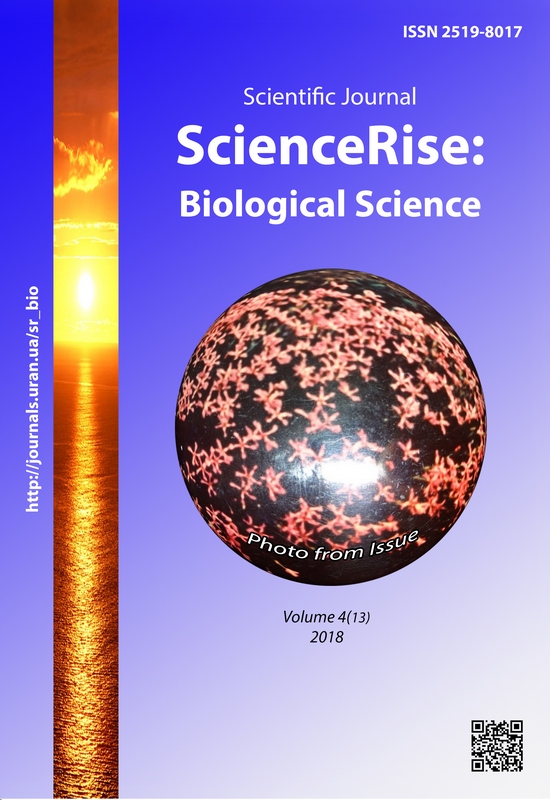Effects 4-(1-adamantyl)-phenoxy-3-(n-benzyl, n-dimethylamino)-2-propanol chloride on the strains of Pseudomonas Spp.
DOI:
https://doi.org/10.15587/2519-8025.2018.141396Keywords:
adamantane derivatives, mode of action, ultrastructure of cell, Pseudomonas aeruginosa, antibacterial actionAbstract
Pseudomonas aeruginosa is one of the main pathogens of nosocomial infections. High resistance of P. aeruginosa to modern antimicrobial agents leads to the decrease in the effectiveness of antibiotic chemotherapy and the need to search for new active compounds. Adamantane derivatives with a wide range of biological activity can be considered as a promising class of substances with an antimicrobial effect.
Aim. In the present study, our purpose was to examine susceptibility and ultrastructural alterations of P. aeruginosa cells under the influence of 4-(1-adamantyl)-phenoxy-3-(N-benzyl, N-dimethylamino)-2-propanol chloride (compound KVM-97).
Materials and methods. The antimicrobial activity assay of tested compound against bacteria of genus Pseudomonas was determined by serial dilution test in broth. Bacterial cells were exposed to the 0.5 MIC and 2.0 MIC of the KVM-97 for 1, 3, 6 and 24 h. Ultrastructure of intact and treated P. aeruginosa cells was examined by transmission electron microscopy after contrasting by uranyl acetate and lead citrate.
Results. It was shown, that compound KVM-97 inhibited Pseudomonas spp growth at concentration 2.5 μg/ml. Examination of P. aeruginosa ultrastructure using electron microscopy showed that the cell and cytoplasmic membrane were damaged in the presence of KVM-97 (invaginations, ruptures) with followed disorganization of cell contents, lysis and cell death. These changes are dose-dependent, they are registered after 1 hour of exposure with the compound and intensified with the time of incubation.
Conclusions. A study carried out with KVM-97 has shown that the compound possesses significant inhibitory activity against tested bacterial strains. The detected ultrastructural alterations of P. aeruginosa suggest the possible mechanism of action of 4-(1-adamantyl)-phenoxy-3-(N-benzyl, N-dimethylamino)-2-propanol chloride due to its influence on the membrane apparat in bacterial cell
References
- Štimac, A., Šekutor, M., Mlinarić-Majerski, K., Frkanec, L., Frkanec, R. (2017). Adamantane in Drug Delivery Systems and Surface Recognition. Molecules, 22 (2), 297. doi: https://doi.org/10.3390/molecules22020297
- Kapitsa, I. G., Kokshenev, I. I., Valdman, E. A., Voronina, T.A. (2012). Izuchenie effectov inektsionnoi formy gimantana na ekcsperimentalnyh modeliah parkinsonicheskogo sindroma [Study of effects of injection form of gimantan on experimental Parkinson syndrome models]. Farmakokinetika i farmakodinamika, 2, 10‑16.
- Moorthy, N. S., Poongavanam, V., Pratheepa, V. (2014). Viral M2 ion channel protein: a promising target for anti-influenza drug discovery. Mini Rev Med Chem, 14 (10), 819–830.
- Vrynchanu, N. O., Gorushko, G. G., Velichko, O. M., Maksimov, Y. M. (2007). Vzaemodiya pohidnogo adamantanu z komponentami biomembran [Interaction between adamantane derivative with biomembrane components]. Visnyk Binnitskogo natsionalnogo medychnogo universitety, 11 (2/1), 534–535.
- Vrynchanu, N. O., Sergienko, O. V., Maksimov, Y. M. (2009). Doslidzhennia deiakyh storin mehanizmu antygrybkovoi diyi novogo pohidnogo adamantanu [Research of some aspects of the mechanism of antifungal action of novel adamantane derivative]. Morfologiya, 3 (2), 24–27.
- Korotkyi Yu. V., Lozynskyi M. O., Vrynchanu N. O., Denysiuk N. M., Maksymov Yu. M. (2008). Pat. No. UA. 1-[4-(1-Adamantyl-phenoxy]-3-(N-benzene, N-dimethylamino)-2-propanol chloride. MPK C07C 213/00. No. a200804978; declared: 17.04.2008; published: 10.02.2010, No. 3.
- Volianskyi, Yu. L., Hrytsenko, Sh. S., Shyrobokov, V. P. et. al. (Eds.) (2004). Vyvchennia spetsyfichnoi aktyvnosti protymikrobnyh likarskih zasobiv [Study of specific activity of antimicrobials]. Kyiv, 38.
- Hagler, H. K. (2007). Ultramicrotomy for Biological Electron Microscopy. Electron Microscopy, 67–96. doi: https://doi.org/10.1007/978-1-59745-294-6_5
- Ellis, E. A. (2007). Poststaining Grids for Transmission Electron Microscopy. Electron Microscopy, 97–106. doi: https://doi.org/10.1007/978-1-59745-294-6_6
- Venerucci, F. et. al. (Eds.) (1998). Histopathology Kits: methods and applications. Bologna, Milan: Bio Optica, 95.
- Gilleland, H. E. JR, Murray, R. G. E. (1976). Ultrastructural study of polymyxin-resistant isolates of Pseudomonas aeruginosa. Journal of bacteriology, 125 (1), 267–281.
- Bouhdid, S., Abrini, J., Amensour, M., Zhiri, A., Espuny, M. J., Manresa, A. (2010). Functional and ultrastructural changes in Pseudomonas aeruginosa and Staphylococcus aureus cells induced by Cinnamomum verum essential oil. Journal of Applied Microbiology, 109 (4), 1139–1149. doi: https://doi.org/10.1111/j.1365-2672.2010.04740.x
- Martin, N. L., Beveridge, T. J. (1986). Gentamicin interaction with Pseudomonas aeruginosa cell envelope. Antimicrobial Agents and Chemotherapy, 29 (6), 1079–1087.doi: https://doi.org/10.1128/aac.29.6.1079
- Kadurugamuwa, J. (1997). Natural release of virulence factors in membrane vesicles by Pseudomonas aeruginosa and the effect of aminoglycoside antibiotics on their release. Journal of Antimicrobial Chemotherapy, 40 (5), 615–621. doi: https://doi.org/10.1093/jac/40.5.615
- Moghoofei, M., Fazeli, H., Poursina, F., Nasr Esfahani, B., Moghim, S., Vaez, H. et. al. (2015). Morphological and Bactericidal Effects of Amikacin, Meropenem and Imipenem on Pseudomonas aeruginosa. Jundishapur Journal of Microbiology, 8 (11). doi: https://doi.org/10.5812/jjm.25250
- Latha, L. Y., Darah, I., Kassim, M. J. N. M., Sasidharan, S. (2010). Antibacterial Activity and Morphological Changes ofPseudomonas aeruginosaCells after Exposure toVernonia cinereaExtract. Ultrastructural Pathology, 34 (4), 219–225. doi: https://doi.org/10.3109/01913121003651513
- Strachunskii, L. S., Belousov, Y. B., Kozlv S. N. (2007). Prakticheskoe rukovodstvo po antiinfectsionnoi himioterapii [Practical guideline for anti-infective chemotherapy]. Smolensk: MakMaX, 464.
Downloads
Published
How to Cite
Issue
Section
License
Copyright (c) 2018 Daria Dudikova, Sergei Voychuk, Nina Vrynchanu

This work is licensed under a Creative Commons Attribution 4.0 International License.
Our journal abides by the Creative Commons CC BY copyright rights and permissions for open access journals.
Authors, who are published in this journal, agree to the following conditions:
1. The authors reserve the right to authorship of the work and pass the first publication right of this work to the journal under the terms of a Creative Commons CC BY, which allows others to freely distribute the published research with the obligatory reference to the authors of the original work and the first publication of the work in this journal.
2. The authors have the right to conclude separate supplement agreements that relate to non-exclusive work distribution in the form in which it has been published by the journal (for example, to upload the work to the online storage of the journal or publish it as part of a monograph), provided that the reference to the first publication of the work in this journal is included.









